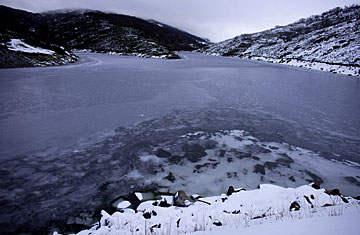
Guthega is the river's first stop as it moves through the dams and power stations of the Snowy Hydro Scheme
During winter, the highest river in Australia begins life as a glittering patch of ice under the snow-clad shoulders of Mt. Kosciuszko. It trickles around the edges of a frozen pool, vanishes and reappears in an open snowy bowl. Bathed in sunlight, it's a spectacular vista, colored today by a group of kite sledders who find this an ideal spot to harness the chill alpine breeze.
Shouting and whooping, the men wrestle their 5-m-long multicolored aerofoil into the sky against a backdrop of milky peaks. "Excellent climb, excellent, Wooo!" calls out instructor Pat Spiers, his voice audible for hundreds of meters. But without warning a gust of wind picks up the kite and dumps it in a tangle of string and fabric.
Here in the mountains, the weather turns the headwaters and slopes around the Snowy River into a high-altitude Bermuda Triangle, swallowing bodies for months or years before surrendering them in a spring thaw. In just the first 2 km of what in summer is a cheery brook rushing through mountain meadows, blizzards, mists and extreme temperatures have claimed the lives of seven men and one woman.
Mountain guide Bruce Easton says the terrain in winter is featureless. "People don't realize just how quickly it can change. There are people who have climbed Everest who will not go out up here in certain conditions."
On a ridge overlooking the river stands a tiny two-roomed stone hut topped with a soot-blackened chimney. Inside are wooden benches, a pot-bellied stove and small tables, beneath a plaque that tells the visitor the hut was built in 1929 as a memorial to American tourist Laurie Seaman. With his friend Evan Hayes, Seaman decided to ski to the summit of Mt. Kosciuszko on August 14, 1928. After reaching the top, the pair split up as they headed down the mountain. As the wild weather blew in, Seaman waited in this spot for his friend. Hayes never arrived; Seaman's body was found a month later, frozen to death in a sitting position. Hayes' body was found a year later above Lake Cootapatamba, collapsed on his skis. A camera was found with the bodies; when the film was developed, it showed pictures of the pair on the summit of Kosciuszko on the day they died.
Tonight the hut is pleasantly warm thanks to the timber-guzzling stove, but when the fire goes out at 2:00 a.m., even a minus-15-rated sleeping bag becomes bitterly cold. Mountaineer Spiers, in training for an impending polar expedition, has a long association with the hut. He recalls one climber staggering in from a blizzard carrying nothing but a large ice axe, dressed in a pair of rugby shorts and thermal underwear: "He stood in the door and said, 'That was bad.'" The man had gone for a quick hike up Kosciuszko, got lost and started to dig a snow trench to wait out the blizzard. "He's digging away, and then suddenly a park ranger skis by," says Spiers. "The ranger looks up and sees him and shows him which way to go back to the hut. He was lucky."
On another wall is a picture of four men wearing climbing harnesses and ropes, looking young and invincible against a backdrop of wild and treed mountains. On Aug. 7, 1999, Timothy Friend, 25, Dean Pincini, 25, and brothers Scott,26, and Paul Beardsmore, 24, set off from the top of one of nearby Thredbo's chairlifts for a threeday back-country snowboarding trip. Just 2 km from the chairlift, they became caught in one of the worst blizzards of the season.
As experienced mountaineers were fleeing the slopes, the men are believed to have dug a snow cave, eaten a meal and then curled up in their sleeping bags. The wind howled outside, bringing the fresh powder they were hoping to carve up the next day, but inside their ice cocoon, the snowboarders never woke up. Despite a massive search, no trace of them was found until months later, when a helicopter pilot saw the remains of their thawing cave.